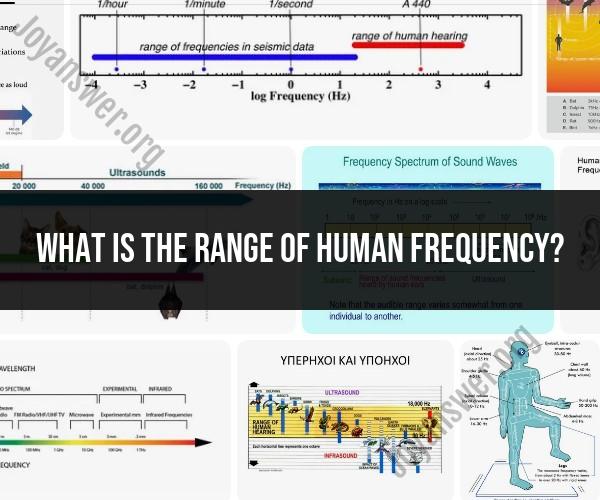What is the range of human frequency?
The range of frequencies that the average human can hear, known as the human audible range, typically spans from approximately 20 Hertz (Hz) to 20,000 Hertz (20 kHz). However, this range can vary from person to person, and it tends to decrease with age.
Infrasound: Sounds with frequencies below 20 Hz are called infrasound. While some animals can hear sounds in this range, humans can generally feel or sense very low-frequency sounds, especially at high intensities. Infrasound is often used in the study of earthquakes and other natural phenomena.
Audible Range: The bulk of sounds that we hear and use for communication and entertainment fall within the range of about 20 Hz to 20,000 Hz. This range includes the sounds of music, speech, and most environmental sounds.
Ultrasound: Frequencies above 20 kHz are referred to as ultrasound. These sounds are too high-pitched for humans to hear, but they have many practical applications in fields like medicine (ultrasound imaging), industry (ultrasonic cleaning), and even pest control (ultrasonic pest repellents).
Keep in mind that individual variations in hearing ability can cause some people to hear a broader or narrower range of frequencies. Additionally, as people age, their ability to hear high-pitched sounds often diminishes, a condition known as presbycusis.
Human Frequency Range: Understanding the Sounds We Hear
The human frequency range is the range of sound frequencies that can be heard by the human ear. It is generally considered to be between 20 Hz and 20,000 Hz (20 kHz). However, this range can vary from person to person, and it tends to decrease with age.
The auditory system is responsible for converting sound waves into electrical signals that can be interpreted by the brain. The outer ear collects sound waves and directs them into the middle ear. The middle ear amplifies the sound waves and transmits them to the inner ear. The inner ear contains the cochlea, which is a spiral-shaped organ that contains hair cells. The hair cells convert the sound waves into electrical signals that are sent to the brain.
The brain interprets the electrical signals from the cochlea to create the perception of sound. The pitch of a sound is determined by its frequency. High-frequency sounds have a higher pitch than low-frequency sounds. The loudness of a sound is determined by its amplitude. High-amplitude sounds are louder than low-amplitude sounds.
The Auditory Spectrum and Human Hearing Abilities
The auditory spectrum is the entire range of sound frequencies that can be detected by any animal. The human auditory spectrum is a subset of the auditory spectrum that is detectable by the human ear.
The human ear is most sensitive to sounds in the frequency range between 2,000 and 5,000 Hz. This is the frequency range of most human speech. The human ear is also sensitive to sounds in the frequency range between 1,000 and 2,000 Hz. This is the frequency range of most musical instruments.
Humans can distinguish between approximately 1,400 pitches. This means that we can hear a very wide range of different sounds. This ability is essential for communication, music, and other activities.
The Science of Sound Frequencies and Their Applications
Sound frequencies have many different applications in science and technology. For example, sound frequencies can be used to:
- Measure distances (e.g., sonar)
- Detect objects (e.g., ultrasound)
- Communicate (e.g., telephones, radios)
- Produce music (e.g., musical instruments, speakers)
- Treat medical conditions (e.g., lithotripsy)
Age-Related Changes in Human Frequency Range
The human frequency range tends to decrease with age. This is because the hair cells in the cochlea can become damaged over time. The damage to the hair cells can make it difficult to hear high-frequency sounds.
The age-related decline in hearing is usually gradual and begins at around the age of 8. However, some people may experience a more rapid decline in hearing. The rate of decline can vary from person to person.
Exploring Ultrasound and Infrasound Beyond Human Hearing
Ultrasound is sound with frequencies above 20 kHz. Infrasound is sound with frequencies below 20 Hz. Humans cannot hear ultrasound or infrasound, but other animals can.
Ultrasound is used in a variety of applications, including medical imaging, sonar, and nondestructive testing. Infrasound is used in a variety of applications, including earthquake monitoring, volcano monitoring, and military applications.
Conclusion
The human frequency range is the range of sound frequencies that can be heard by the human ear. The human ear is most sensitive to sounds in the frequency range between 2,000 and 5,000 Hz. The human frequency range tends to decrease with age. Ultrasound and infrasound are sound frequencies that are beyond the range of human hearing, but they have many different applications in science and technology.












